Sourdough bread, known for its thick, chewy crust and soft, airy interior, is a classic example of traditional baking’s simple elegance. Made with just flour, salt, and water, sourdough has surged in popularity the last few years, attracting beginner and seasoned bakers alike! The key to its distinctive taste and texture lies in the sourdough starter, a fermented mixture that naturally leavens the bread. This guide simplifies the process of creating and maintaining your own starter, and it teaches you how to bake your own sourdough loaf.
If you love homemade bread, you absolutely need to try homemade French bread, cinnamon swirl bread, and this easy sandwich bread.
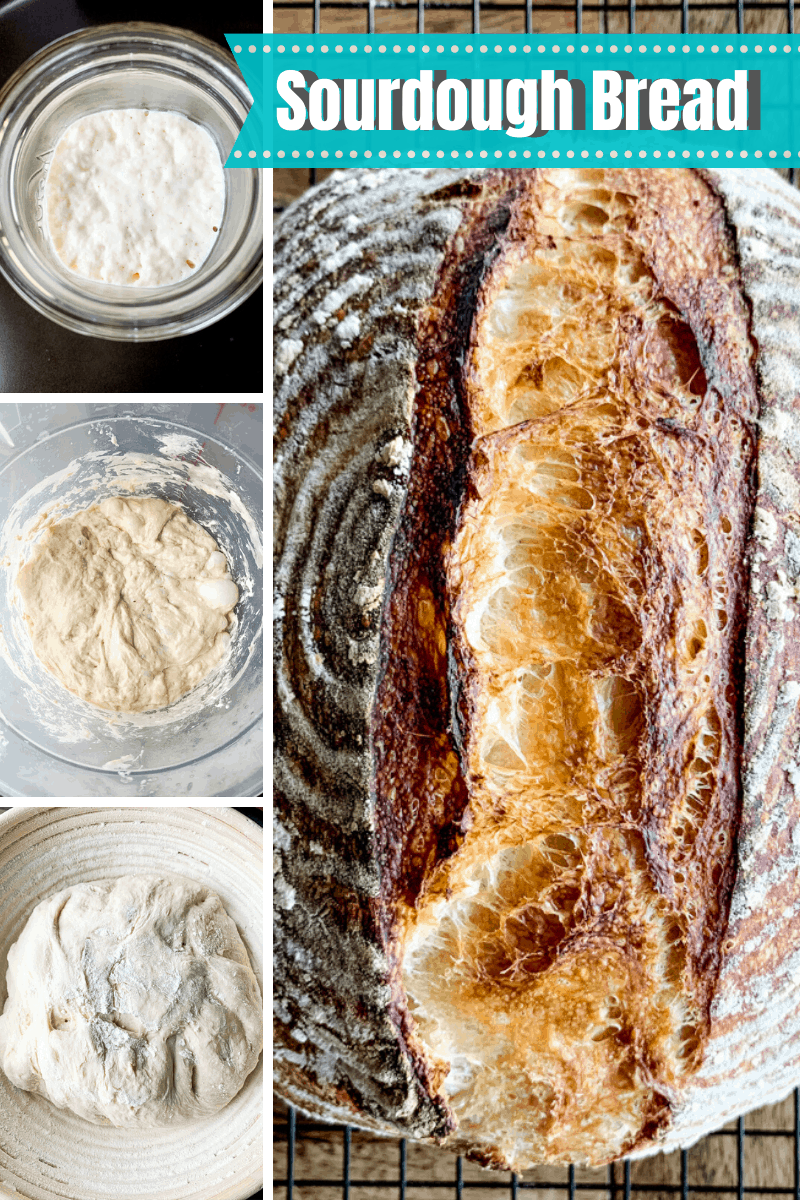
Sourdough Bread Recipe
We know many people are looking for an easy introduction to sourdough, without worrying about technique, so consider this your introductory lesson to making sourdough starter and bread from scratch. There are many methods and recipes for sourdough out there, and we are just focusing on one simple method. If you graduate from this and want to get fancy, there is a lot more to try out with sourdough baking!
The most important first step is to have a sourdough starter. You might already know someone with a starter, and if so, you’ve got an easy head start! You don’t need a lot, just get a couple of tablespoons and then immediately feed. If you aren’t lucky enough to have family or friends with an active sourdough starter, you can make your own from flour, water, and a bit of patience.
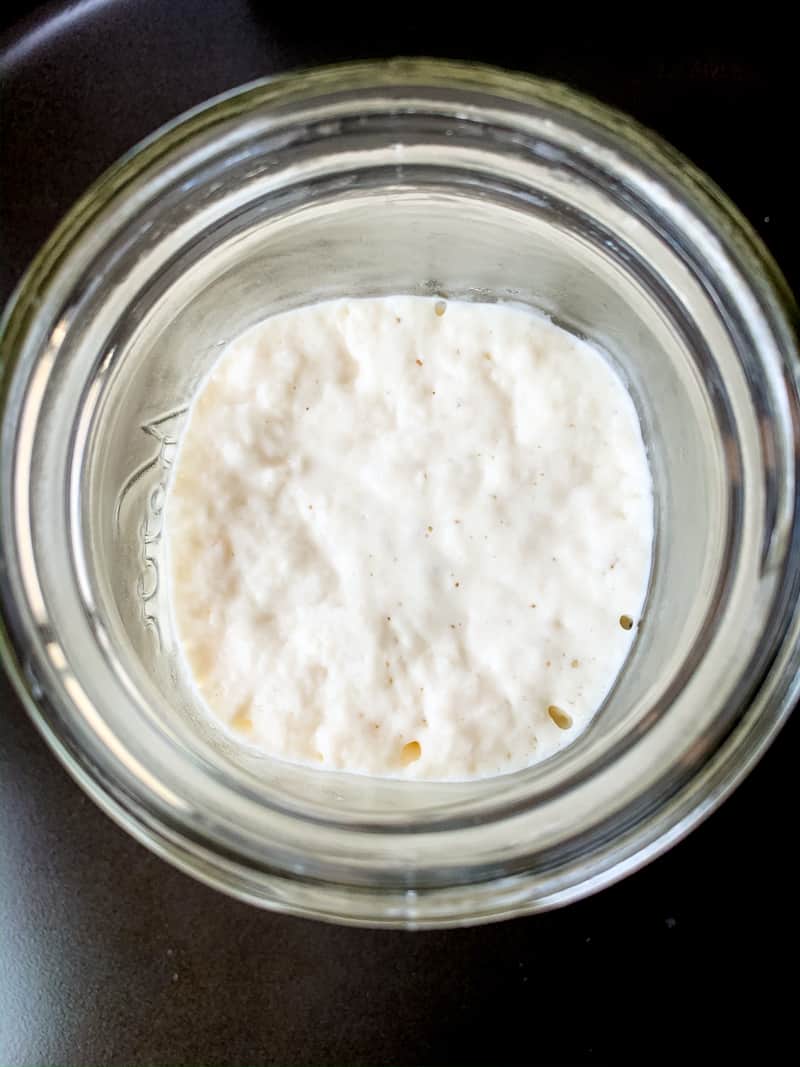
How to Make Your Own Sourdough Starter:
Wild yeast lives in the air and flour, it’s everywhere really! Breads made from wild yeast do not require commercial yeast. To make your own wild yeast sourdough starter
- Fill a larger plastic or glass container with 1/2 cup flour and 1/2 cup water. Stir until thoroughly combined into a smooth batter.
- Cover with a loosely screwed on lid or plastic wrap.
- “Feed” your starter 4 ounces of water and flour, stirring until combined, every 24 hours.
- Notice any air bubbles day to day, both large and small, that means it’s working and the wild yeasts are doubling! It should start to smell sour after a few days, but room temperature can affect how quickly it activates. Don’t worry too much about it, just keep feeding it every day. The texture will change from a pancake dough batter to an airy, lighter batter over the first 5 days.
- By day 5, or once it smells sour and is airy and doubling in volume, it is ready to use in your preferred sourdough bread recipe!
How to Maintain a Sourdough Starter
If you bake bread often, you can leave your starter on the counter and feed daily to keep it active. We like to feed 5 Tablespoons of both flour and water. You’ll find that your jar can’t contain that much starter, as it will double in size each time you feed it. You can either discard a bit of starter before each feed, or you can save it and use in waffles, pancakes, pizza dough, or even fry up that discarded starter in oil and add some seasonings as a delicious, sourdough ‘pancake!’ Just always make sure to leave at least 2 tablespoons of starter behind to continue to feed. You never want to use it all up.
If you want to only make bread once each week or less, keep your starter stored in the fridge. 2 days before you’re ready to make bread, remove it from the fridge and feed and leave on the counter. 24 hours later, feed it again. It could take anywhere from 2-5 hours for the starter to be fully active and ready to use after that second feed. Once it is fully active and doubled in size, you are ready to bake. Make sure to feed your starter after each discard or use.
Using Your Sourdough Starter: Making the Dough
Now that your starter has doubled in size and is billowing at the top, you are ready to make your bread dough. We like a larger loaf, so mix 5 cups of flour with 2 cups of water. Either all purpose or bread flour will work, though we prefer bread flour. You can start mixing with a wooden spoon if you like, but you’ll realize pretty quickly that a spoon will only get you so far, and you’ll want to switch to just mixing by hand. The dough will be really sticky and thick. Let the dough rest for 45 minutes with a lid on or covered in plastic wrap. This resting process where gluten development begins is called the autolyse.
First Rise
After 45 minutes, add in 1 Tablespoon salt and 1/2 cup of your starter to the water/flour mixture. Mix this all in by hand until well combined, but do not knead. Let it rise for anywhere from 12-24 hours. In the winter, when the house is cooler, we let this rise for about 20 hours. In the summer, we stick fairly close to 12-14 hours. You just want it to double in size. Without adding any commercial yeast, this can be a fairly long process, so we tend to do this first rise overnight.
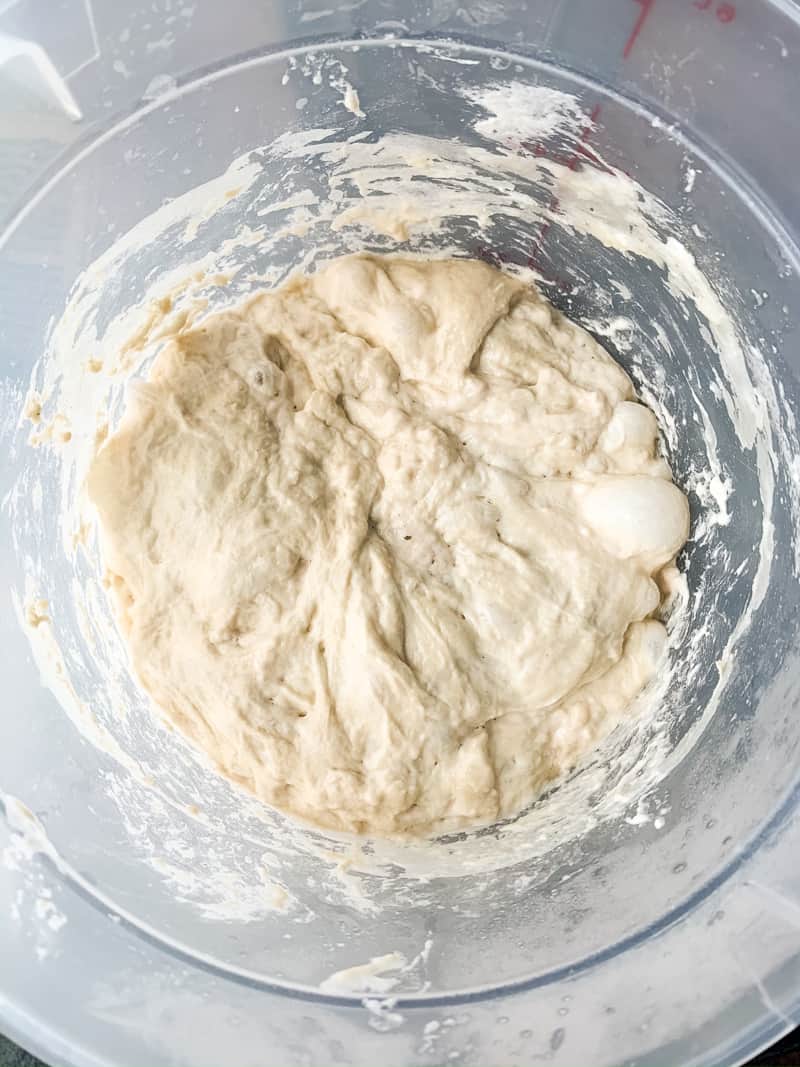
Second Rise
Once the dough has doubled in size, dump it out onto a clean, floured surface and fold it over a few times into the center. Transfer this to an oiled bowl or to a floured proofing basket. Let it rise for 3-5 hours. You’ll know it’s ready when you poke it with your finger (not too harshly) and the indent remains, or only very slowly springs back while still leaving an indent. If the dough springs right back, it needs more time to rise.
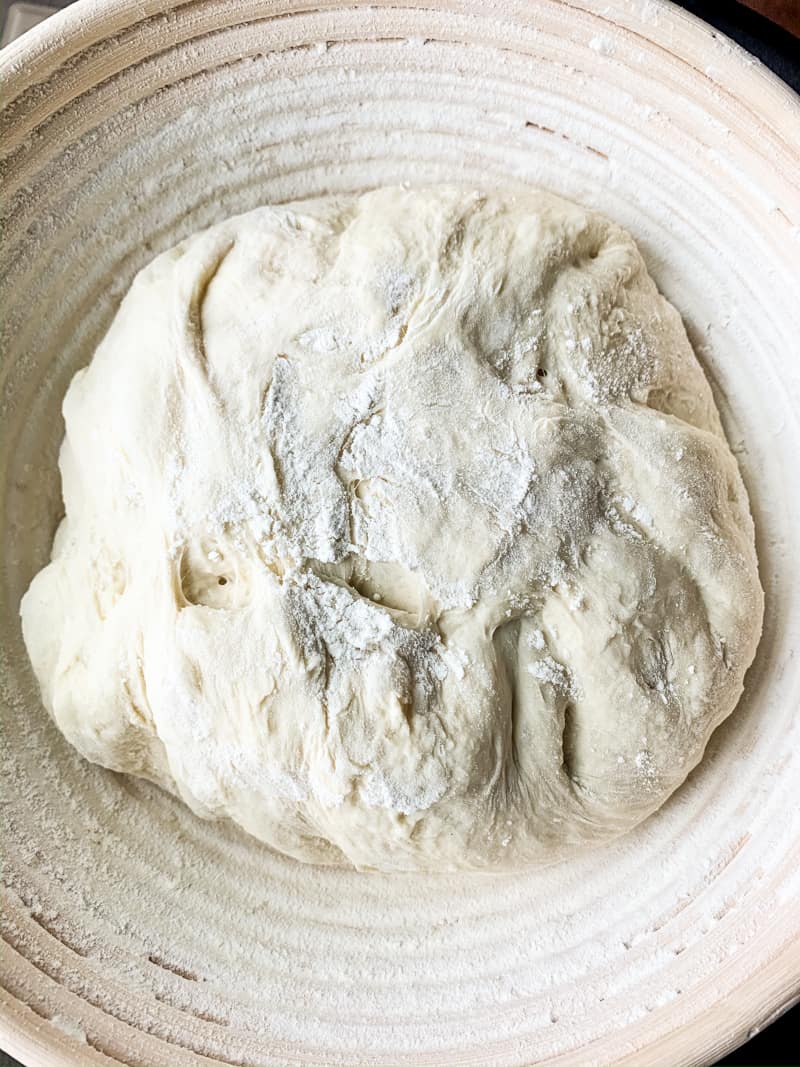
Baking Sourdough Bread
Once your dough is fully risen, preheat your oven to 450 degrees Fahrenheit with your dutch oven in the oven for the entire preheating time. Flip your dough from your basket/bowl onto a bread sling or large piece of parchment paper. Use that excess parchment paper to help lift the dough into the dutch oven. Put lid on and bake for 30 minutes. After 30 minutes, remove the lid and continue to bake until bread is a deep brown, approximately 30 more minutes.
PRO TIP: Put a baking sheet under your dutch oven when you remove the lid, and bake for the remaining time this way. This will ensure the bottom of the bread doesn’t get too dark or burn.
Once the bread is a deep brown, turn off oven and crack the door. Let your bread cool in the cracked oven for 20 minutes before removing from oven and dutch oven, and putting on a cooling rack. Cutting into a warm loaf of bread is SO tempting, but it is important to let the bread cool completely to allow texture and flavor to develop completely.
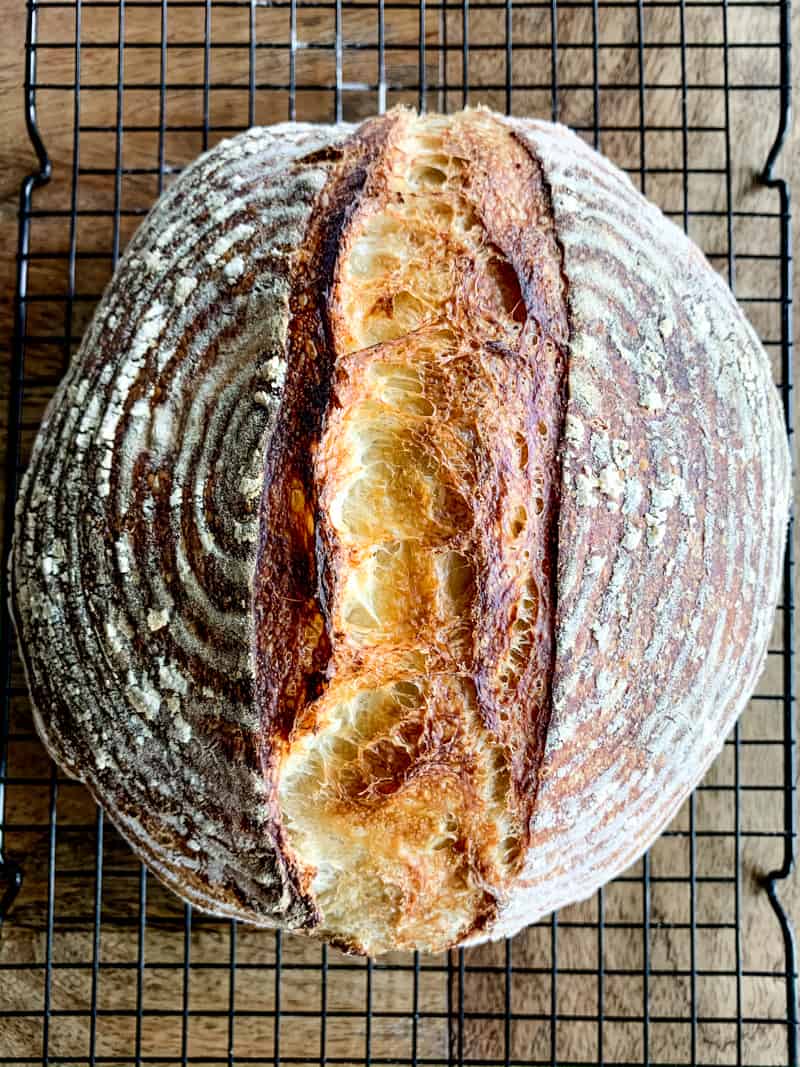
Storage Instructions for Sourdough Bread
Room Temperature Storage:
- Cool the bread completely before storing.
- Wrap the bread in a clean, dry cloth or place it in a paper bag to maintain its crust’s texture.
- Store in a cool, dry place for up to 3 days.
Refrigerator Storage:
- Not recommended, as it can dry out the bread and affect texture.
Freezer Instructions for Sourdough:
- Slice the bread if desired for easier use.
- Wrap slices or whole loaves tightly in plastic wrap or aluminum foil.
- Place wrapped bread in a freezer bag or airtight container.
- Label the bag or container with the date.
- Freeze for up to 3 months.
To Thaw:
- Leave at room temperature, wrapped, until thawed. For slices, you can toast directly from frozen for convenience.


So excited to find you have a recipe for sourdough starter! I’ve been wanting to give it a try. You are one if my go-to’s for recipe inspiration. I’m no spring chicken in the kitchen but it’s nice to have some expert advice when trying something new. I know your recipes are well-tested and always wonderful! Thanks for all you do!
Aw, thank you so much! That means the world to hear. Sourdough is such a fun (and tasty!) kitchen adventure, and we’re so excited you’re giving the starter a try! It’s totally normal to feel a little intimidated at first, but once you get into the rhythm, it’s super rewarding
This is my first loaf of sourdough ever. I halved the recipe because I only have a small Dutch over. It turned out so well! It’s so easy and so yummy!
So glad you were able to enjoy it! Nothing like having a fresh loaf.
Your sourdough starter making steps are simple to follow. Thank you for sharing this awesome recipe. I will post a bread results soon.
Looking forward to hearing how it went!
There’s no mention of stretch and folds Is the dough just allowed to stay on the counter for 12-24 hours?
Yes, this recipe is designed to be a simpler, no-knead method, so it doesn’t include stretch and folds. The dough rests on the counter for 12-24 hours, allowing time for gluten to develop naturally. However, if you prefer more structure in your sourdough, you can absolutely add stretch and folds during the first few hours of fermentation—doing 3-4 sets, spaced 30 minutes apart, can help improve the dough’s strength and texture. But as written, the recipe works without them!
Bread is delicious. One question: after second rising and flip bread onto parchment paper, my loaf lost its round shape. It flatten and so I stuffed it into the dutch oven. I thought I had ruined it but it rose and tasted great. Can you tell me what I did wrong?
It sounds like your dough may have over-proofed during the second rise, which can cause it to spread and lose its shape when transferred. Sourdough is more delicate after proofing, so handling it gently is key. Next time, try shortening the second rise slightly or making sure your dough has enough structure by building strength with stretch-and-folds during the bulk fermentation.
Another trick is to place the shaped dough in the fridge for the final proof—this helps firm it up, making it easier to transfer while still holding its shape. But it’s great to hear it still baked up well and tasted delicious!
Silly question but what size Dutch oven are you using for this size recipe? Thank you!
I typically use a 5 quart dutch oven.
I’ve now made three batches of this bread. I don’t have a dutch oven, so I did the first one in a stone cake pan. It browned nicely, seemed to be a good size, and sounded hollow when I did the thump test. When I cut it though, it was not properly cooked. Today I mixed two batches. I followed the test for second rising, and was satisfied the dough had risen properly. I baked these loaves in a large cast iron pan, placing a smaller, ice-cube filled cast pan below the baking pan. I started one batch considerably after the second, so each loaf baked alone. Both browned beautifully, sounded hollow…but again, both are doughy inside. The first time, I used convection setting, but when I realized the humidity is a factor, I opted for standard baking. I’m baffled. I’ve been baking yeast breads for decades, but really like the taste, texture and digestibility of sourdough. Please advise.
Your comment did not specify if you had a lid on your cast iron pan while baking. If not, that would be our first suggestion to try baking with a lid. It is also possible that your oven runs a little on the cool side. Most ovens are a bit off to some degree. We recommend using an oven thermometer to check the accuracy of your oven’s temperature when baking.